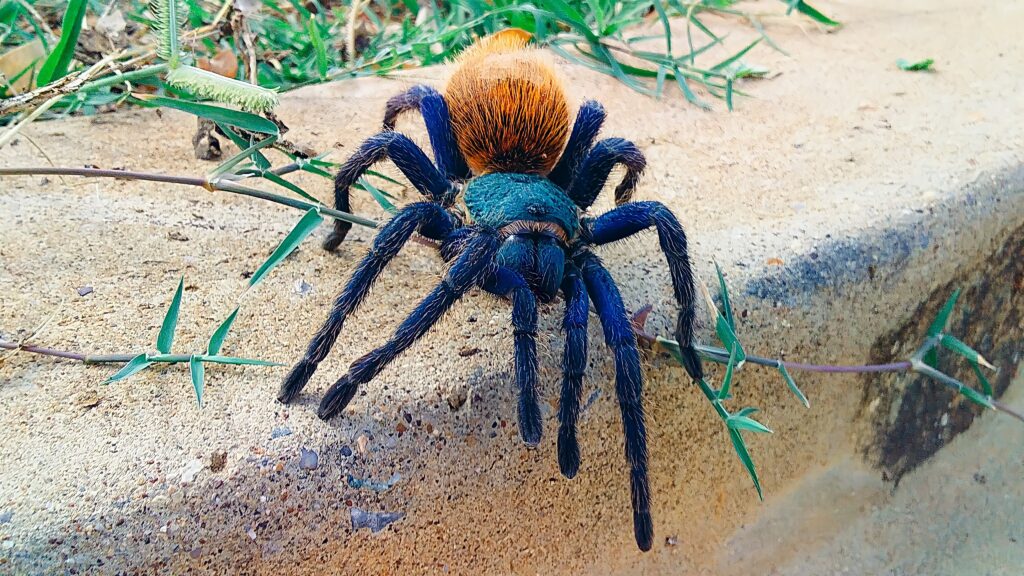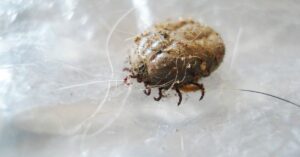
Welcome to our article all about tarantula mites and parasites.
Picture the scene. You wander over to your tarantula enclosure to feed it and notice all these little white specks around its mouth and all over its abdomen. Are they mites? Are they parasites? Are they going to kill your tarantula? How do you get rid of them? So many questions. We’ll try and answer them all, and more, for you.
Although tarantulas are becoming an ever-increasing pet, it can still be difficult to get them to a vet that will treat it, so you need to take care of the matter yourself. Time could be of the essence here, so without further ado, lets get into the thick of it.
What are Tarantula Mites?

Mites that appear in tarantula enclosures (and also feeder colonies) are purely scavenger mites that live off rotting organic matter.
In a similar way to springtails, they feed off anything they can find, including spider poop, fungi, and even rotting coco fibre.
When the enclosure becomes over-populated or the mites run out of food, they hitch a ride on your tarantula to seek out more suitable surroundings.
As mites are so tiny, they can’t really walk a great distance, hence the need to use your tarantula as a free taxi so to speak.
The mites, now called phoretic (‘hitchhiker’) mites, jump onto your tarantula and find a place with softer skin to attach themselves with their mouth parts. Prime real estate is the area around the chelicerae.
It’s like going through a drive in McDonalds, every time the tarantula eats, the mites get to clean up afterwards. They sometimes even share the tarantula’s meal.
They don’t suck hemolymph or anything else from the tarantula, unlike parasites which we will deal with next.
Symptoms
Unfortunately, mite populations can explode in just a matter of days providing conditions are in their favour so always try to keep temperatures correct and don’t let anything get too wet.
At the same time, a dry enclosure is bad for your tarantula, it’s a case of finding the right balance.
Other than seeing white flecks on your tarantula, you will notice your spider standing on tiptoes, moving and scratching himself a lot.
Can you imagine how irritating it must be for him? All these mites running around and biting into him for a free ride? Ugh.
How to Get Rid of Mites
As these mites have attached themselves securely to your tarantula with their mouth parts, never try to brush or pick them off. Doing so can actually damage your pets exoskeleton.
Lure them Out
In the first instance, place a small piece of rotting organic matter inside the enclosure close to your tarantula (think fruit, vegetables, dead cricket etc.).
The mites will smell the food and leave their free taxi to have dinner. After a few hours and preferably using a spoon, remove the rotting piece of whatever you put in so that all mites feeding on their feast will be collected, too.
This needs to be repeated several times to have any effect.
Springtails
Adding springtails to the enclosure works too as they both favour the same foodstuffs, so will balance the population out.
Cleaning
This should be a no-brainer but the other way to get rid of them is to completely empty the enclosure (having safely re-housed your tarantula first of course).
Using warm water only as chemicals could be harmful to your animal, give the enclosure a good clean, replace all substrate and clean any additional materials you have inside (hides, cork bark, plants etc).
It may be easier to simply buy a brand new enclosure with brand new additions to avoid even 1 mite being left behind.
Prevention
Unfortunately, it is impossible to prevent mites entering your tarantula’s enclosure. Mites are lightweight, small, and everywhere, even the air.
The best way I’ve found of controlling the mite population is by ensuring I always add springtails to my enclosures.
Now onto parasites.
Nematode Parasite

Unfortunately, tarantulas can get parasites just like any other living creature, the nematode being a common one for tarantulas.
What is a Nematode Parasite?
Nematode worms are microscopic non-segmented worms that occur naturally in soil all around the world.
Most are harmless to your tarantula but there are some species that are major parasites in invertebrates. They transmit bacteria that is lethal to its host.
Wild caught spiders are sometimes imported carrying these worms and if not properly dealt with, they can spread throughout a collection with devastating effects.
Nematode worms penetrate their host through any small opening (usually via the book lungs or the anus). They then spread throughout the entire spider to eventually emerge through the mouth.
Symptoms
Up until the final stages of infection, the tarantula’s behaviour is quite normal and, unfortunately, when the symptoms are noticed, it is usually too late.
Although devastating when present, nematode worms are relatively rare in collections and by taking the right precautions and procedures, you can at least limit the amount of damage they do.
There are a few ways of checking, some obvious, some not so immediately obvious. The most obvious one is that your tarantula will have white worms coming out of their mouth.
Other ways of testing for parasites are as follows:
- Gently shake your tarantula’s enclosure. If he does not steady himself with all of his legs (including placing his palps on the floor), this could be a sign he has a parasite infection.
- Try feeding. An affected tarantula cannot attack prey.
- Is your tarantula restless, spending long periods of time around his water dish or spinning unusual amounts of silk?
- Does he have a very wet sternum (caused by drooling)?
If any of the above is present in your tarantula, he may unfortunately have a parasite infection.
Treatment
If not caught soon enough, nematodes can cause severe damage to a tarantula’s stomach and intestines. They can cause too much bacteria, which makes them unable to respond positively to any drugs administered.
If you believe one of your tarantulas has been infected with nematode worms, you should quarantine it away from the rest of your collection immediately.
One approach that may work is to place the spider in a tub tilted to one side (include a small amount of water) inside a polystyrene box with a heat mat attached to a thermostat.
Raise the temperature to over 36 degrees Celsius and leave for 5 days, changing the water and cleaning the tub daily.
It is said that nematode worms become inactive below 12 degrees Celsius and die with the temp is above 35 degrees Celsius.
All species of tarantulas may not be able to tolerate high temperatures like this, so use caution.
After 5 days the worms should die and the spider’s mouth should be clear. Unfortunately, most tarantulas treated this way still eventually die by the time the worms start to exit the mouth due to internal damage that is irreversible.
However, it’s still worth a try if this is your only hope.
Prevention
Again, the only way of thorough prevention is to routinely carry out a spot check of your tarantula’s enclosure and keeping good husbandry.
We know that is quite a depressing end to this article, so to finish on a more positive note, why not take a look at the most colourful tarantulas there are to cheer yourself up a bit. Until next time, stay spidery!
